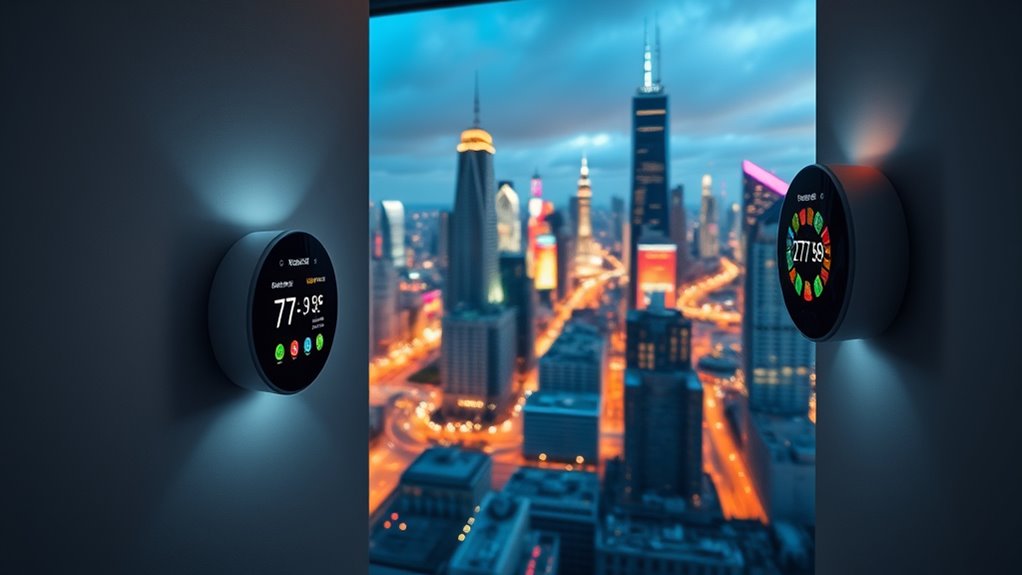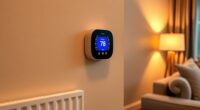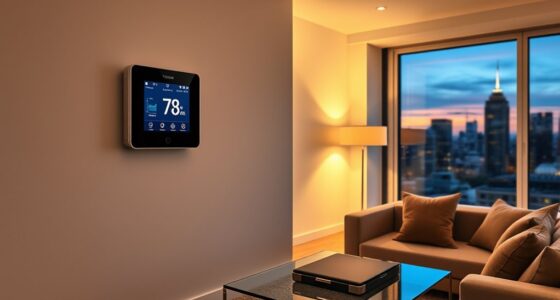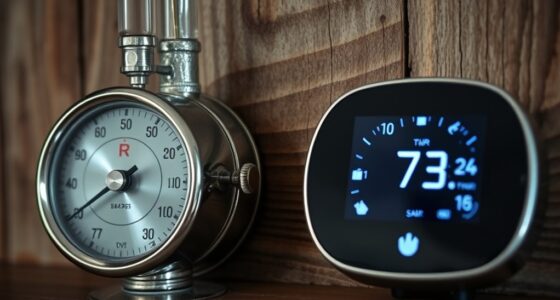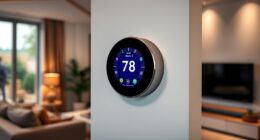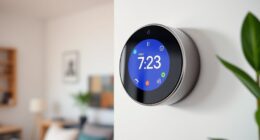Smart thermostats play a vital role in smart cities by helping you manage energy use more efficiently. They learn your routines and adjust settings automatically, reducing waste and lowering utility bills. Real-time feedback and personalized features keep you engaged in sustainable habits. By actively participating, you contribute to urban energy savings and environmental goals. If you want to understand how these devices foster community sustainability and city resilience, there’s more to discover ahead.
Key Takeaways
- Smart thermostats enhance urban energy efficiency through personalized automation and real-time consumption monitoring.
- They promote sustainable behaviors by providing feedback, cost savings, and environmental impact insights.
- User engagement with these devices enables cities to optimize energy use and support broader sustainability initiatives.
- Learning features adapt to individual routines, reducing waste and ensuring comfort in smart city environments.
- Collective participation in smart thermostat programs contributes significantly to urban resilience and environmental goals.
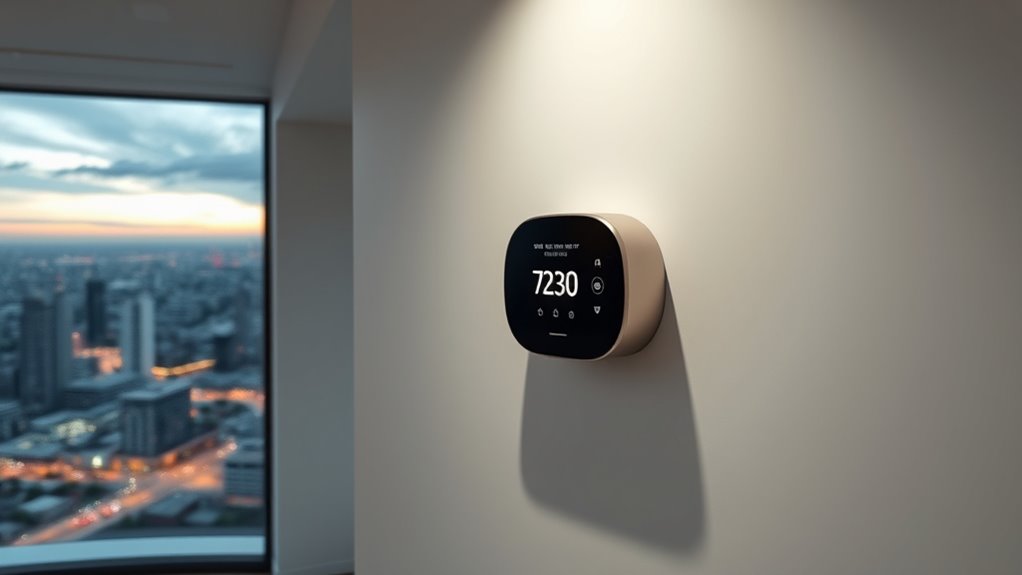
As cities grow smarter, integrating technologies like smart thermostats becomes essential for improving energy efficiency and resident comfort. These devices are more than just fancy temperature controls; they’re critical tools in managing energy consumption effectively. When you use a smart thermostat, you actively participate in energy conservation efforts, reducing unnecessary heating or cooling when spaces are unoccupied or when conditions don’t require it. This not only lowers utility bills but also supports broader environmental goals by decreasing overall energy demand. The key to maximizing these benefits lies in user engagement — the more you interact with and understand your smart thermostat, the better you can optimize its features for your lifestyle and the city’s sustainability objectives.
Active engagement with smart thermostats enhances energy efficiency and supports urban sustainability goals.
Smart thermostats learn your routines over time, adjusting settings based on your habits and preferences. For example, if you typically turn down the heat at night, the device recognizes this pattern and automates it, ensuring comfort without waste. You’re encouraged to personalize these settings, which fosters a sense of control and responsibility for your energy use. This active participation is essential in a smart city context, where collective efforts lead to significant energy savings. When you’re engaged with your device, you’re more likely to make informed decisions about your energy consumption, such as scheduling heating or cooling for specific times or leveraging features like geofencing to turn off or adjust the thermostat when you leave home.
Additionally, smart thermostats facilitate real-time monitoring and feedback, making it easy for you to see how your actions impact energy use. You might receive alerts or insights about unusual energy consumption, prompting you to make adjustments. This transparency increases user engagement, transforming passive consumption into active management. Cities can leverage this data to identify patterns and implement broader efficiency initiatives, but it all begins with your involvement. Your participation not only helps you save money but also contributes to citywide energy conservation efforts, creating a more sustainable urban environment. Emphasizing ongoing user education can further enhance your understanding and effective use of these devices.
Furthermore, user engagement with smart thermostats encourages a cultural shift towards mindful energy use. When residents see tangible benefits—like reduced bills or a smaller carbon footprint—they’re more motivated to adopt other sustainable behaviors. Cities can support this by providing educational resources and incentives, fostering a community that values energy efficiency. Studies show that real-time monitoring significantly increases user interaction and habit formation for sustainable practices. Ultimately, smart thermostats in smart cities are more effective when you’re actively involved; your engagement makes these technologies work smarter, leading to a more sustainable, comfortable, and efficient urban future. Engaging with these devices also helps foster a culture of sustainability, which is vital for long-term urban resilience.
Frequently Asked Questions
How Do Smart Thermostats Impact Urban Energy Consumption?
Smart thermostats help you reduce urban energy consumption by encouraging behavior change, like adjusting your heating and cooling habits. When many people use them, they contribute to grid stability by balancing demand during peak times. This means less strain on the energy grid, lower costs, and reduced emissions. You can actively participate in creating a smarter, more sustainable city while saving money and helping the environment.
Are Smart Thermostats Compatible With All Building Types?
Smart thermostats aren’t compatible with all building types due to building adaptability and installation challenges. You might find that older or non-standard buildings require extra modifications, making installation more complex. While they work well in modern, well-insulated structures, you should assess your building’s specific needs to guarantee compatibility. Overcoming these challenges can open energy savings and improve overall climate control in your space.
What Privacy Concerns Arise With Smart Thermostat Data?
Your smart thermostat’s data acts like a delicate thread weaving through your daily life, raising privacy concerns. You need to be mindful of data security, ensuring your personal habits aren’t exposed or misused. Protecting user privacy means safeguarding this information from prying eyes, preventing unauthorized access. As these devices learn your routines, it’s essential to stay vigilant, so your comfort doesn’t come at the expense of your privacy.
How Do Smart Thermostats Integrate With Other City Infrastructure?
You see smart thermostats connect seamlessly with building automation systems, enabling efficient climate control and energy management. They also integrate with grid infrastructure through real-time data sharing, helping balance energy demand during peak times. This synergy improves overall city efficiency, reduces costs, and supports sustainable development. By linking with other infrastructure, smart thermostats play a crucial role in creating smarter, more responsive urban environments.
What Are the Cost Savings for Residents Using Smart Thermostats?
Using smart thermostats, you can see significant energy bill reduction because they optimize thermostat efficiency by adjusting your home’s temperature based on your schedule and preferences. This smart technology learns your habits, reducing unnecessary heating or cooling. As a result, you save money each month, making your energy consumption more efficient and cost-effective. Over time, these savings add up, helping you cut costs while maintaining comfort.
Conclusion
As you embrace smart thermostats, you become the heartbeat of a city that breathes in harmony. Like a conductor guiding an orchestra, your device orchestrates comfort and energy flow, shaping a smarter, greener future. With each tap, you ignite the flame of innovation, turning your home into a lighthouse guiding your city towards sustainability. In this dance of technology and nature, you hold the power to light the way for a brighter, more connected tomorrow.
